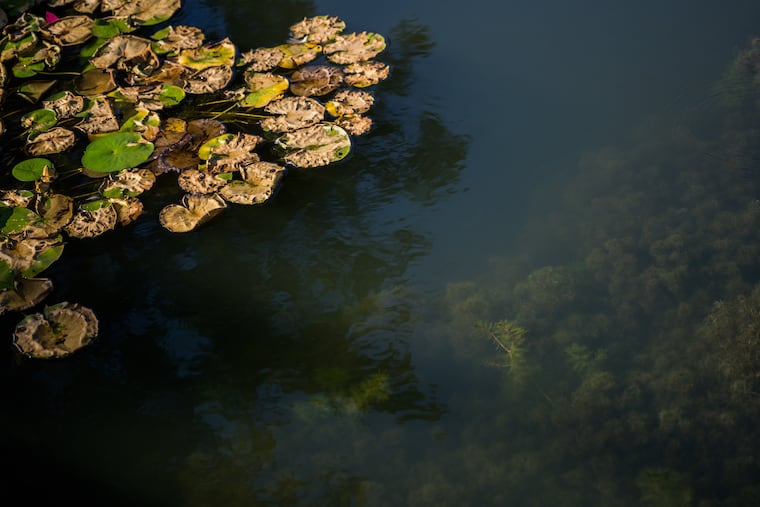N.J. creates warning system for harmful algal blooms after last year’s lake closings
Remember all those harmful algal blooms that frightened pet owners and closed lakes throughout New Jersey last year? Now, the state has come up with a color-coded warning system to let people know if it's safe to take a dip.

Remember the harmful algal blooms that frightened pet owners and closed lakes throughout New Jersey last year? Now, the state has created a color-coded warning system to let residents know which lakes are safe for taking a dip or paddling a kayak.
The New Jersey Department of Environmental Protection developed the index to give guidance on what recreational activities are appropriate for waterways impacted by harmful algal blooms, also known as HABs or blue-green algae.
The toxic trend in the Garden State began last June with the closure of the state’s largest freshwater lake, Hopatcong in Sussex County. As warnings spread throughout much of the state, including South Jersey, into the fall, officials urged the public to avoid swimming, water sports, and boating in lakes. Officials also said fish caught in the affected streams and lakes should not be eaten, and pets or livestock should not come into contact with the waterways.
The state experienced 40 harmful algal blooms in 2019.
Blue-green algae, a yearly occurrence at some lakes and ponds, caught national attention last year when four dogs died in North Carolina and Georgia after swimming in a pond loaded with it. Soon afterward, New Jersey was forced to close lakes affected with multiple outbreaks.
Blue-green algae is the common name for a type of cyanobacteria, though the bacteria aren’t truly a form of algae. Cyanobacteria can produce toxins harmful to people, pets, and livestock. They mostly grow in freshwater lakes and streams, but are also found in marine waters, such as estuaries.
When blue-green algae grow excessively, it’s called a bloom. Usually, growth is triggered by a combination of sunlight, high temperatures, and nutrients, generally from lawn and farm fertilizers and animal waste.
The blooms form dense mats resembling pea soup or spilled paint, according to the DEP. Exposure in humans can cause mild to moderate health effects, including rashes, allergy-like reactions, flu-like symptoms, gastroenteritis, and respiratory and eye irritation. Incidental ingestion can have more serious health effects, such as liver toxicity and neurological impacts. Children and pets are more vulnerable because they ingest more water in relation to their size.
The DEP says its index will make it “clearer to the public that in some instances, boating and related activities may still be permissible when lower levels of harmful algal blooms are detected.”
To create the index, DEP scientists used data collected during HABs in the last three years to create a tiered warning system. There is no forecast as to whether HABs will return this summer.
“We can’t predict with certainty when harmful algal blooms will occur,” DEP Commissioner Catherine McCabe said in a statement, “but with this enhanced communication and color-coded alert index, we hope that the appropriate responses to harmful algal blooms will become much more predictable and targeted, which should provide much more certainty as well as flexibility for residents and businesses to make sensible decisions.”
The DEP says it will alert the public when bacteria counts become excessive. Here is a summary of the tiers:
Watch: Posted when cell counts exceed 20,000 cells but pose fewer serious health effects than higher tiers. Beaches are open.
Alert: For public bathing beaches only; indicates when a HAB has been confirmed, with cell counts between 40,000 and 80,000 and no known toxins above the public health threshold. Affected beaches won’t be closed, but will be monitored for increases.
Advisory: When cell counts exceed 80,000 cells or when toxin levels exceed 3 micrograms per milliliter of microcystins, extra caution is needed. Beaches are closed. Swimming is not recommended, nor is boating, such as kayaking or canoeing, because of the chance of incidental ingestion.
Warning: When HABs are producing very high levels of toxins. New Jersey has had about a dozen HAB events over the last three years that would trigger a warning. Beaches are closed.
Danger: To date, HABs monitored in New Jersey have not reached this level.
State Sen. Anthony M. Bucco (R., Morris), whose district includes Lake Hopatcong, welcomed the system, which he said gives clarity to closures.
“We were deeply concerned when Lake Hopatcong and other recreational lakes around New Jersey were shut down last year for much of the summer due to state standards for algal blooms that were much stricter than virtually anywhere else,” Bucco said in a statement. “That approach hit our lakeside communities and their economies hard."
Now, he said, “lakes that were closed completely last year could remain open to various forms of recreation in many instances."